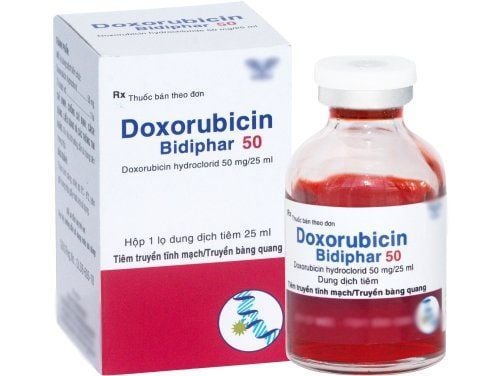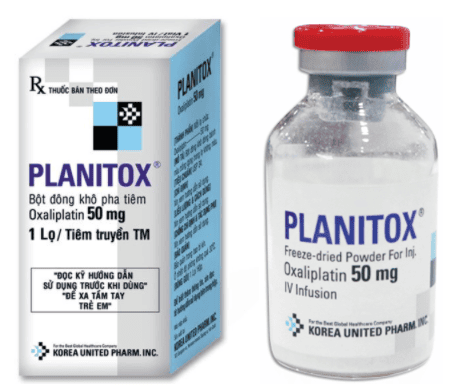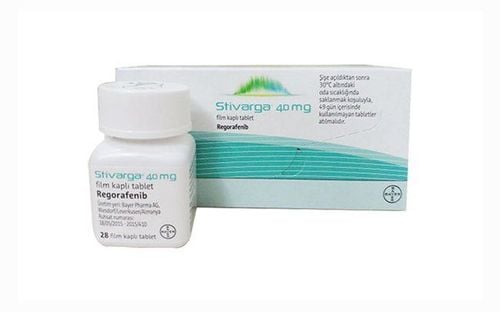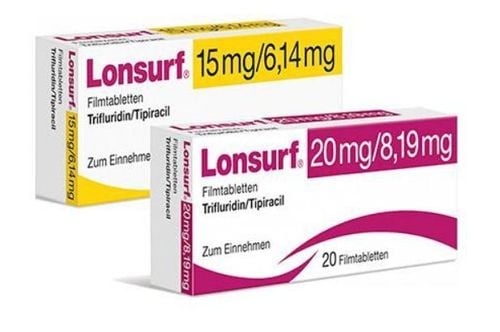This is an automatically translated article.
Capecitabine is an active ingredient that is selectively toxic to cancer cells. This active ingredient is present in the drug Xelocapec. So what effect does Xelocapec have and what problems should be noted when treating with this product?
1. What is Xelocape?
Xelocapec contains active ingredient Capecitabine 500mg. Xelocapec is in the form of film-coated tablets and packed in a box of 3 blisters x 10 tablets.
Xelocapec contains active ingredient Capecitabine which is a fluoropyrimidine carbamate derivative with selective cytotoxic effects on cancer cells. Although Capecitabine did not show cytotoxic effects in vitro, in vivo Xelocapec was continuously converted to the cytotoxic 5-fluorouracil (5-FU). The formation of 5-FU in the tumor is optimally catalyzed by the related angiogenic factor, Thymidine phosphorylase, thereby minimizing the effect of 5-FU on the healthy parenchyma.
2. What are the effects of Xelocapec?
Xelocapec is indicated for the treatment of cancer alone or in combination with other cancer therapies. Xelocapec slows or stops the growth of cancer cells, thereby reducing tumor size in the following cases:
Breast cancer : Xelocapec in combination with Docetaxel is indicated for the treatment of advanced breast cancer in localization or metastasis after failure of chemotherapy; Colorectal cancer: Xelocapec is indicated to support the treatment of colon cancer after surgery or metastatic colorectal cancer; Stomach cancer: Xelocapec in combination with platinum compounds is indicated for the initial treatment of patients with gastric cancer. Contraindications of Xelocapec :
Patients with hypersensitivity to Capecitabine or other ingredients contained in Xelocapec ; People with a history of serious adverse reactions during treatment with fluoropyrimidine; People who are pregnant or breastfeeding; Severe renal impairment (creatinine clearance <30mL/min); Patients undergoing cancer treatment with Sorivudin or a chemically similar substance such as Brivudin; Patients with Dihydropyrimidine dehydrogenase deficiency; Patients with severe low white blood cell or platelet counts; Severe liver failure.
3. Dosage of Xelocape
Dosage of Xelocapec as single treatment:
Colorectal cancer, breast cancer: 1250mg/m2, orally twice daily for 14 days, followed by 7 days of discontinuation. Xelocapec dose in combination therapy:
Breast cancer: The starting dose is 1250mg/m2, 2 times a day for 2 weeks in combination with Docetaxel, followed by 1 week of stopping the drug; Stomach, colorectal cancer: The recommended dose is 800-1000mg/m2/time x 2 times/day for a period of 2 weeks, then 7 days to stop the drug or 625mg/m2/time x 2 times daily when treating continuous treatment. Xelocapec should be taken with food, so the best time is within 30 minutes after a meal.
4. Xelocapac side effects
Unusual symptoms such as nausea, vomiting, decreased appetite, constipation, body fatigue, weakness, headache, dizziness, trouble sleeping may occur while taking Xelocapec. In particular, nausea and vomiting can be severe, so sometimes a doctor should prescribe appropriate control drugs. Diarrhea is another common side effect of Xelocapec. Patients should drink plenty of fluids during treatment with Xelocapec unless otherwise directed by their doctor. Prolonged vomiting or diarrhea caused by Xelocapec can lead to severe dehydration, so contact your doctor immediately if you have symptoms of dehydration such as decreased urination, dry mouth, increased thirst. or dizziness.
Temporary hair loss occurs while taking Xelocapec and is reversible after treatment has ended. Some patients report temporary nail changes.
For men and women of childbearing age, Xelocapec may affect the patient's ability to have children. Patients should consult their doctor for more details.
Xelocapec may decrease the body's immunity to infectious agents, leading to an increased risk of serious (but rarely fatal) infections or making existing infections more serious. more important.
Very serious allergic reactions to Xelocapec are very rare. However, patients should contact their doctor immediately if they develop symptoms of a serious allergic reaction such as rash, itchy swelling of the face/tongue/throat, severe dizziness or difficulty breathing.
5. Xelocapac drug interactions
Capecitabine active ingredient in Xelocapec drug can occur serious drug interactions with some of the following drugs:
Anticoagulant Coumarin: In a clinical interaction study, after taking a single dose of Warfarin 20mg in combination with Capecitabine made increased S-warfarin AUC by 57% and INR values by 91%. Patients receiving coumarin-derivative anticoagulants with Xelocapec should be carefully monitored for changes in coagulation tests (PT or INR) and the anticoagulant dose adjusted accordingly; Cytochrome P450 CYP2C9 Substances: No formal drug interaction studies have been conducted with Xelocape and drugs metabolised by P450 CYP2C9, therefore careful monitoring is recommended when Xelocapec is co-administered with these drugs; Phenytoin: Phenytoin blood levels are increased when administered concomitantly with capecitabine. Therefore, patients receiving combination therapy with Phenytoin and Xelocapec should be carefully monitored for symptoms due to increased blood levels of Phenytoin; Bevacizumab: There was no clinically relevant effect of Bevacizumab on the pharmacokinetic parameters of Xelocapec or its metabolites; Gastric Antacids: The effects of aluminum hydroxide and magnesium hydroxide-containing antacids on the pharmacokinetics of capecitabine have been studied in cancer patients. Plasma concentrations of capecitabine and one metabolite were slightly increased but no effect was observed on the three major metabolites (including 5-DFUR, 5-FU and FBAL); Sorivudine and Similar Drugs: A clinically significant interaction between sorivudine and Xelocapec is due to the inhibition of Dihydropyrimidine dehydrogenase by Sorivudine. This interaction leads to increased toxicity of dihydropyrimidine dehydrogenase, which can be life-threatening. Therefore, Xelocapec should not be taken with Sorivudine or similar drugs (such as Brivudine). Also at least 4 weeks after the end of treatment with Sorivudine or similar drugs before starting Xelocapec therapy; Oxaliplatin: There was no clinically significant difference when Oxaliplatin was combined with Xelocapec or its metabolites. Free or total platinum occurs when Xelocapec and Oxaliplatin are used in combination therapy, with or without bevacizumab; Leucovorin: The effect of Leucovorin on the pharmacokinetics of Xelocapec has been studied in cancer patients. The results showed that Leucovorin had no effect on the pharmacokinetics of capecitabine and its metabolites. However, Leucovorin has an effect on the pharmacodynamics of Capecitabine, which may increase the toxicity of Xelocapec. The cancer treatment drug Xelocapec can cause a lot of unwanted side effects, so patients should only use it when prescribed by a doctor.
Be especially careful when appointing Xelocapec to people who are allergic to the ingredients of the drug, children, the elderly, pregnant women, people with liver disease or kidney disease. Patients should be closely monitored during the use of Xelocapec.
Please dial HOTLINE for more information or register for an appointment HERE. Download MyVinmec app to make appointments faster and to manage your bookings easily.













